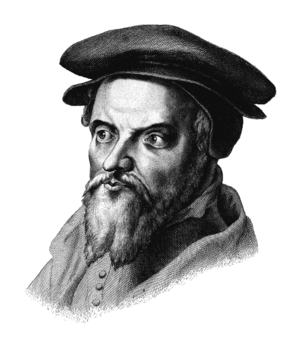
Peter Martyr Vermigli
1499–1562
The Phoenix of Florence
By Chris Castaldo
From childhood, Peter Martyr Vermigli desired to teach God’s word. At age fifteen, he entered the Augustinian order in the Italian town of Fiesole, near his native Florence. After eight years of theological training, Vermigli underwent priestly ordination and received a doctorate in theology.
The years following Vermigli’s ordination opened new vocational horizons. He was elected to the office of public preacher, an illustrious position in his day. As his name grew famous in the largest Italian cities, Vermigli was promoted to the position of abbot in his order’s monastery in Spoleto, before being moved southward to the great basilica San Pietro ad Aram in Naples. It was here that his life changed forever.
Righteousness Restored
During Vermigli’s sojourn at San Pietro (1537–1540), according to his colleague and biographer, Josiah Simler, “the greater light of God’s truth” began to shine upon him. This truth, in Vermigli’s words, was that “Christ’s righteousness imputed to us by God totally restores what was lacking in this weak and mutilated righteousness of ours” (The Peter Martyr Reader, 147). It was a gospel awakening that transformed his life and ministry.

With a new vision of Christ and the gospel, Vermigli moved north in May 1541 to become prior of the prestigious monastery of San Frediano in the Republic of Lucca. While there, he initiated a series of educational and ecclesiastical reforms that have been likened to Calvin’s work in Geneva.
But after a mere fifteen months of such gospel renewal, Pope Paul III ensured its demise by reinstituting the Roman Inquisition. Recognizing discretion as the better part of valor, Vermigli renounced his vows and made the difficult decision to flee his homeland.
From Strasbourg to Oxford
It was Martin Bucer who arranged for Vermigli’s academic appointment to the College of Saint Thomas in Strasbourg. The Italian exile was expected to teach sacred letters, which he proceeded to do from the Old Testament.
While in Strasbourg, Vermigli also married a former nun from Metz named Catherine Dammartin, “a lover of true religion” especially admired for her charity. After eight years of marriage, she died in February 1553, but Peter Martyr would marry again — another Katie — in May 1559.
Following five fruitful years of teaching in Strasbourg, Vermigli received an invitation in 1547 from Archbishop of Canterbury Thomas Cranmer to fortify the newly independent Church of England with Reformed theology as Regius Chair of Divinity at Oxford. Among Vermigli’s many accomplishments in this period, he lectured on Romans, produced various theological treatises, championed Protestantism at the famous Eucharistic Disputation of 1549, and assisted Cranmer in shaping a new Anglican liturgy.
Zurich Scholar
With the accession of the Catholic Queen Mary in 1553, Vermigli was forced to flee England. Returning to Strasbourg, he was immediately restored to his position at the Senior School, where, in addition to teaching and writing theological works, he gathered with Marian exiles in his home to study and pray. Eventually, he took a teaching post at the Academy of Zurich.
Despite numerous opportunities to lecture throughout Europe, including multiple invitations from Calvin to teach in Geneva and pastor the Genevan Italian congregation, Vermigli remained in Zurich. The only exception was his journey to the Colloquy of Poissy with Theodore Beza in 1561, where he debated Catholic leaders before the French Crown and witnessed to Queen Catherine de’ Medici in their native Italian.
Teacher of the Book
Vermigli died in Zurich on November 12, 1562, in the presence of his wife and friends. This Florentine humanist and Reformed scholar, who was equal in stature to Calvin and Bullinger, would be remembered for his commitment to Scripture and passion for gospel renewal. In the words of Theodore Beza, he was a “phoenix born from the ashes of Savonarola.” Even the painting of Vermigli hanging in the National Portrait Gallery in London testifies to his biblical conviction. In it, Vermigli’s penetrating eyes look to the distance beyond the gilded frame as he points to a singular book in his hand: the Bible.
If we were to place an enduring statement on Vermigli’s lips, it would perhaps be this exhortation: “Let us immerse ourselves constantly in the sacred Scriptures, let us work at reading them, and by the gift of Christ’s Spirit the things that are necessary for salvation will be for us clear, direct, and completely open” (Life, Letters, and Sermons, 281).
Recent Comments